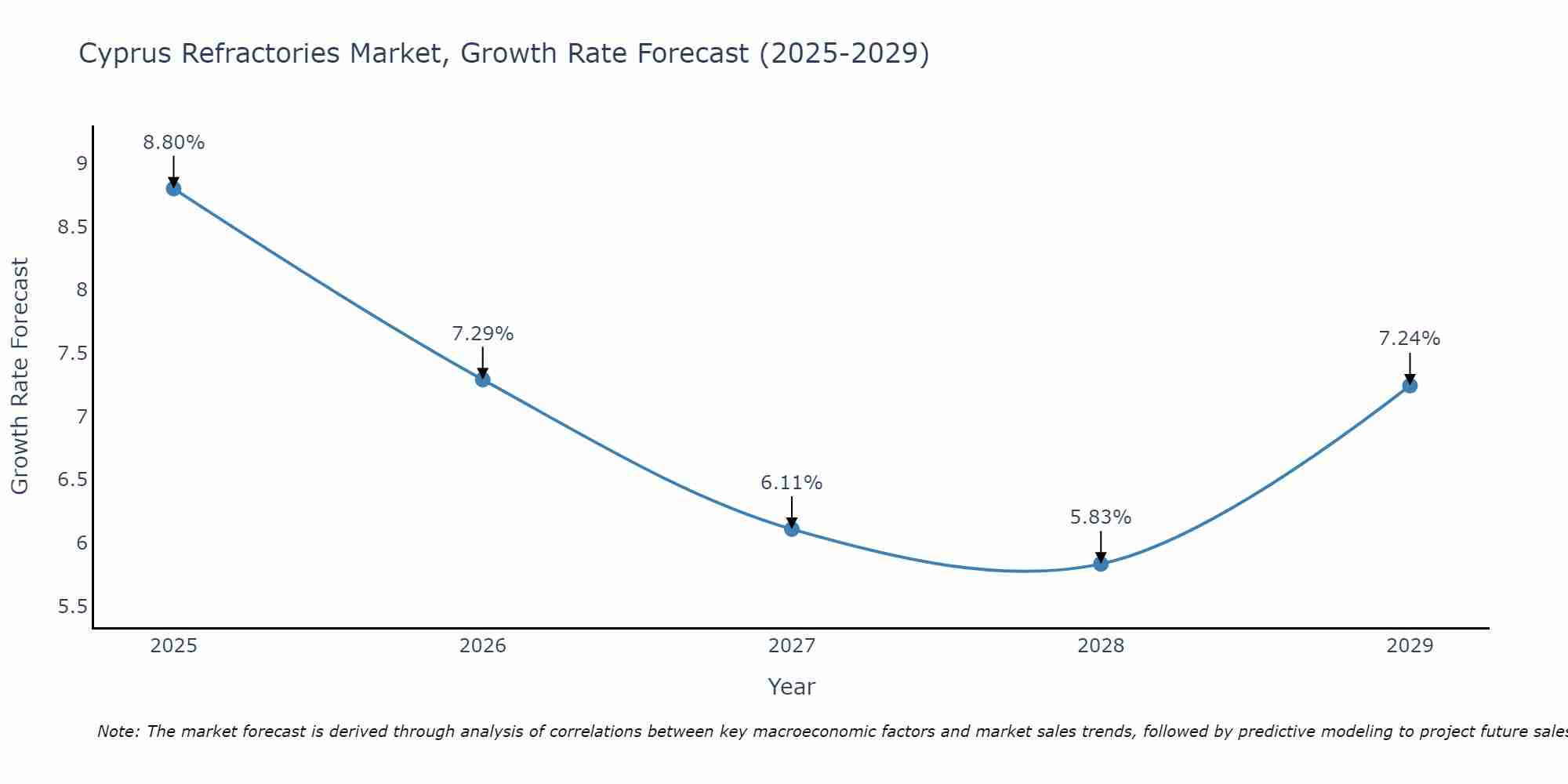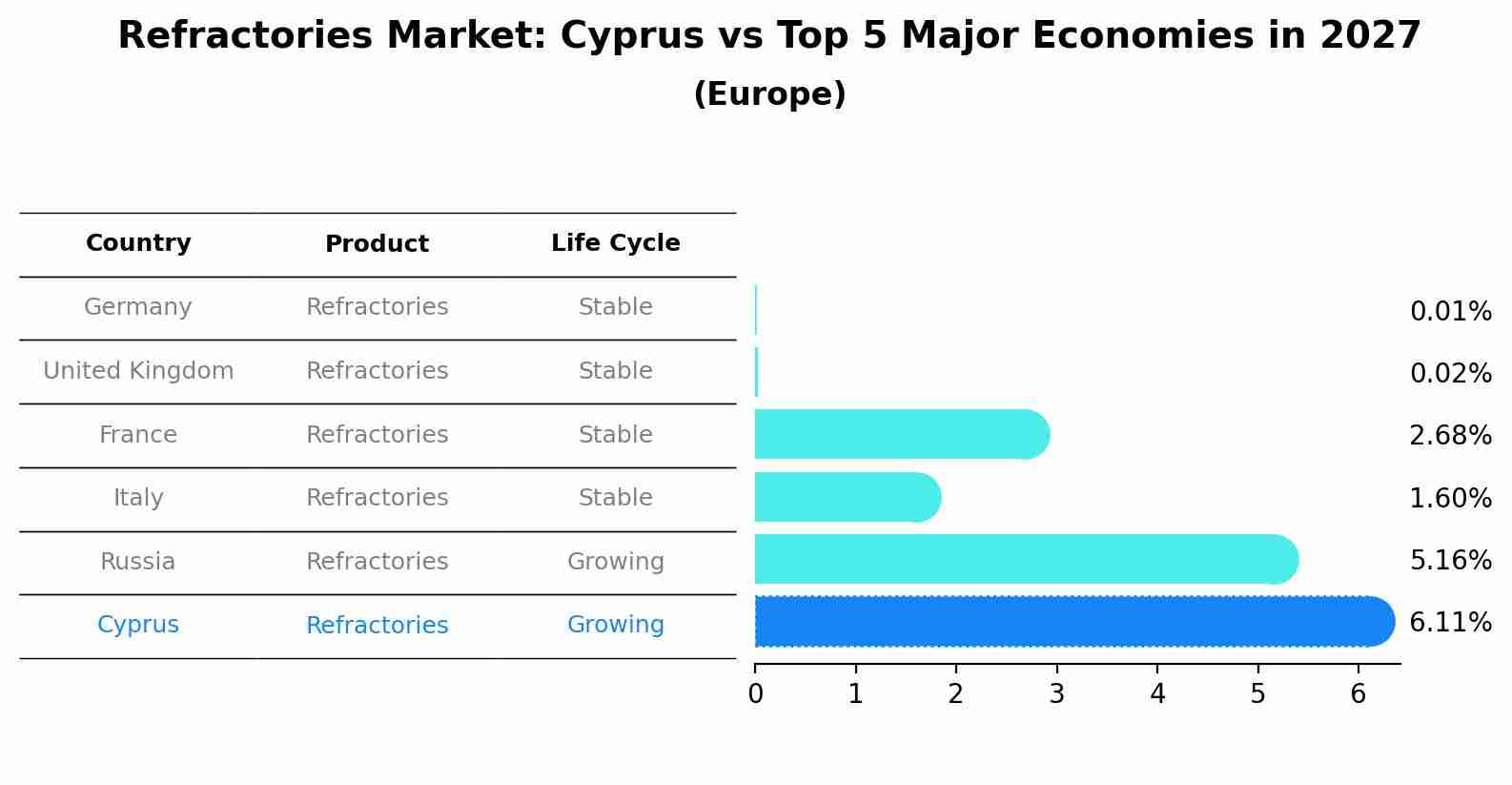Cyprus Refractories Market (2025-2031) | Trends, Industry, Outlook, Growth, Share, Companies, Analysis, Forecast, Value, Size, Segmentation & Revenue
| Product Code: ETC4654758 | Publication Date: Nov 2023 | Updated Date: Apr 2025 | Product Type: Market Research Report | |
| Publisher: 6Wresearch | Author: Shubham Deep | No. of Pages: 60 | No. of Figures: 30 | No. of Tables: 5 |
Cyprus Refractories Market Size Growth Rate
The Cyprus Refractories Market is projected to witness mixed growth rate patterns during 2025 to 2029. Beginning strongly at 8.80% in 2025, growth softens to 7.24% in 2029.

Refractories Market: Cyprus vs Top 5 Major Economies in 2027 (Europe)
The Refractories market in Cyprus is projected to grow at a growing growth rate of 6.11% by 2027, highlighting the country's increasing focus on advanced technologies within the Europe region, where Germany holds the dominant position, followed closely by United Kingdom, France, Italy and Russia, shaping overall regional demand.

Cyprus Refractories Market Overview
The refractories market in Cyprus comprises materials resistant to high temperatures and used in various industrial applications, particularly in metallurgy and glass manufacturing. The increasing demand for metals and glass, driven by construction and automotive industries, is a significant factor propelling market growth. Moreover, the focus on energy efficiency and sustainability is pushing industries to adopt advanced refractory materials that can withstand extreme conditions while minimizing environmental impact. The market is witnessing innovations in refractory technology, including the development of non-toxic and recyclable materials.
Drivers of the market
The Cyprus Refractories Market is significantly influenced by the growth of the construction and manufacturing sectors. Refractories are essential in high-temperature processes, making them crucial for industries such as steel, cement, and glass production. The ongoing infrastructure development in Cyprus, particularly in energy and industrial projects, is driving the demand for refractory materials. Additionally, advancements in refractory technology, which improve the efficiency and lifespan of products, are attracting investments and stimulating market growth.
Challenges of the market
The Cyprus Refractories Market encounters challenges such as high energy costs associated with the production process, which increases overall expenses for manufacturers. Additionally, the market suffers from limited raw material availability, especially for high-grade refractories, forcing reliance on imports. This creates a vulnerability to supply chain disruptions and cost volatility. Another issue is the slow adoption of newer refractory technologies, which could improve efficiency and durability but require significant capital investment that smaller companies may not afford.
Government Policy of the market
Government policies impacting the Cyprus Refractories Market include those related to the construction and manufacturing industries. Cyprus policies on infrastructure development and industrial growth play a crucial role in the demand for refractories used in high-temperature applications such as steelmaking and cement production. Moreover, compliance with EU regulations concerning industrial emissions and energy efficiency can affect the production processes within the refractories industry, pushing companies to adopt more sustainable practices.
Key Highlights of the Report:
- Cyprus Refractories Market Outlook
- Market Size of Cyprus Refractories Market, 2024
- Forecast of Cyprus Refractories Market, 2031
- Historical Data and Forecast of Cyprus Refractories Revenues & Volume for the Period 2021-2031
- Cyprus Refractories Market Trend Evolution
- Cyprus Refractories Market Drivers and Challenges
- Cyprus Refractories Price Trends
- Cyprus Refractories Porter`s Five Forces
- Cyprus Refractories Industry Life Cycle
- Historical Data and Forecast of Cyprus Refractories Market Revenues & Volume By Form Types for the Period 2021-2031
- Historical Data and Forecast of Cyprus Refractories Market Revenues & Volume By Shaped Refractories for the Period 2021-2031
- Historical Data and Forecast of Cyprus Refractories Market Revenues & Volume By Unshaped Refractories for the Period 2021-2031
- Historical Data and Forecast of Cyprus Refractories Market Revenues & Volume By Product Types for the Period 2021-2031
- Historical Data and Forecast of Cyprus Refractories Market Revenues & Volume By Non-clay Refractory for the Period 2021-2031
- Historical Data and Forecast of Cyprus Refractories Market Revenues & Volume By Clay Refractory for the Period 2021-2031
- Historical Data and Forecast of Cyprus Refractories Market Revenues & Volume By End-users for the Period 2021-2031
- Historical Data and Forecast of Cyprus Refractories Market Revenues & Volume By Iron & Steel for the Period 2021-2031
- Historical Data and Forecast of Cyprus Refractories Market Revenues & Volume By Cement for the Period 2021-2031
- Historical Data and Forecast of Cyprus Refractories Market Revenues & Volume By Non-Ferrous Metals for the Period 2021-2031
- Historical Data and Forecast of Cyprus Refractories Market Revenues & Volume By Glass for the Period 2021-2031
- Historical Data and Forecast of Cyprus Refractories Market Revenues & Volume By Others for the Period 2021-2031
- Cyprus Refractories Import Export Trade Statistics
- Market Opportunity Assessment By Form Types
- Market Opportunity Assessment By Product Types
- Market Opportunity Assessment By End-users
- Cyprus Refractories Top Companies Market Share
- Cyprus Refractories Competitive Benchmarking By Technical and Operational Parameters
- Cyprus Refractories Company Profiles
- Cyprus Refractories Key Strategic Recommendations
Frequently Asked Questions About the Market Study (FAQs):
1 Executive Summary |
2 Introduction |
2.1 Key Highlights of the Report |
2.2 Report Description |
2.3 Market Scope & Segmentation |
2.4 Research Methodology |
2.5 Assumptions |
3 Cyprus Refractories Market Overview |
3.1 Cyprus Country Macro Economic Indicators |
3.2 Cyprus Refractories Market Revenues & Volume, 2021 & 2031F |
3.3 Cyprus Refractories Market - Industry Life Cycle |
3.4 Cyprus Refractories Market - Porter's Five Forces |
3.5 Cyprus Refractories Market Revenues & Volume Share, By Form Types, 2021 & 2031F |
3.6 Cyprus Refractories Market Revenues & Volume Share, By Product Types, 2021 & 2031F |
3.7 Cyprus Refractories Market Revenues & Volume Share, By End-users, 2021 & 2031F |
4 Cyprus Refractories Market Dynamics |
4.1 Impact Analysis |
4.2 Market Drivers |
4.3 Market Restraints |
5 Cyprus Refractories Market Trends |
6 Cyprus Refractories Market Segmentations |
6.1 Cyprus Refractories Market, By Form Types |
6.1.1 Overview and Analysis |
6.1.2 Cyprus Refractories Market Revenues & Volume, By Shaped Refractories, 2021-2031F |
6.1.3 Cyprus Refractories Market Revenues & Volume, By Unshaped Refractories, 2021-2031F |
6.2 Cyprus Refractories Market, By Product Types |
6.2.1 Overview and Analysis |
6.2.2 Cyprus Refractories Market Revenues & Volume, By Non-clay Refractory, 2021-2031F |
6.2.3 Cyprus Refractories Market Revenues & Volume, By Clay Refractory, 2021-2031F |
6.3 Cyprus Refractories Market, By End-users |
6.3.1 Overview and Analysis |
6.3.2 Cyprus Refractories Market Revenues & Volume, By Iron & Steel, 2021-2031F |
6.3.3 Cyprus Refractories Market Revenues & Volume, By Cement, 2021-2031F |
6.3.4 Cyprus Refractories Market Revenues & Volume, By Non-Ferrous Metals, 2021-2031F |
6.3.5 Cyprus Refractories Market Revenues & Volume, By Glass, 2021-2031F |
6.3.6 Cyprus Refractories Market Revenues & Volume, By Others, 2021-2031F |
7 Cyprus Refractories Market Import-Export Trade Statistics |
7.1 Cyprus Refractories Market Export to Major Countries |
7.2 Cyprus Refractories Market Imports from Major Countries |
8 Cyprus Refractories Market Key Performance Indicators |
9 Cyprus Refractories Market - Opportunity Assessment |
9.1 Cyprus Refractories Market Opportunity Assessment, By Form Types, 2021 & 2031F |
9.2 Cyprus Refractories Market Opportunity Assessment, By Product Types, 2021 & 2031F |
9.3 Cyprus Refractories Market Opportunity Assessment, By End-users, 2021 & 2031F |
10 Cyprus Refractories Market - Competitive Landscape |
10.1 Cyprus Refractories Market Revenue Share, By Companies, 2024 |
10.2 Cyprus Refractories Market Competitive Benchmarking, By Operating and Technical Parameters |
11 Company Profiles |
12 Recommendations | 13 Disclaimer |
- Single User License$ 1,995
- Department License$ 2,400
- Site License$ 3,120
- Global License$ 3,795
Search
Related Reports
- Portugal Occupational Health & Safety Services Market (2025-2031) | Strategy, Consumer Insights, Analysis, Investment Trends, Opportunities, Growth, Size, Share, Industry, Revenue, Segments, Value, Segmentation, Supply, Forecast, Restraints, Outlook, Competition, Drivers, Trends, Demand, Pricing Analysis, Competitive, Strategic Insights, Companies, Challenges
- Netherlands Occupational Health and Safety Services Market (2025-2031) | Strategy, Consumer Insights, Analysis, Investment Trends, Opportunities, Growth, Size, Share, Industry, Revenue, Segments, Value, Segmentation, Supply, Forecast, Restraints, Outlook, Competition, Drivers, Trends, Demand, Pricing Analysis, Competitive, Strategic Insights, Companies, Challenges
- Belgium and Luxembourg Facility Management Market (2025-2031) | Strategy, Consumer Insights, Analysis, Investment Trends, Opportunities, Growth, Size, Share, Industry, Revenue, Segments, Value, Segmentation, Supply, Forecast, Restraints, Outlook, Competition, Drivers, Trends, Demand, Pricing Analysis, Competitive, Strategic Insights, Companies, Challenges
- Russia Women Intimate Apparel Market (2025-2031) | Strategy, Consumer Insights, Analysis, Investment Trends, Opportunities, Growth, Size, Share, Industry, Revenue, Segments, Value, Segmentation, Supply, Forecast, Restraints, Outlook, Competition, Drivers, Trends, Demand, Pricing Analysis, Competitive, Strategic Insights, Companies, Challenges
- Africa Chocolate Market (2025-2031) | Size, Share, Trends, Growth, Revenue, Analysis, Forecast, industry & Outlook
- Global Hydroxychloroquine And Chloroquine Market (2025-2031) | Industry, Trends, Size, Outlook, Growth, Value, Companies, Revenue, Analysis, Share, Forecast
- Saudi Arabia Plant Maintenance Market (2025-2031) | Industry, Size, Growth, Revenue, Value, Companies, Forecast, Analysis, Share & Trends
- Taiwan Electric Truck Market (2025-2031) | Outlook, Industry, Revenue, Size, Forecast, Growth, Analysis, Share, Companies, Value & Trends
- South Korea Electric Bus Market (2025-2031) | Outlook, Industry, Companies, Analysis, Size, Revenue, Value, Forecast, Trends, Growth & Share
- Africa Low Temperature Powder Coating Market (2025-2031) | Companies, Competition, Size, Challenges, Segmentation, Trends, Competitive, Industry, Supply, Strategy, Investment Trends, Growth, Segments, Restraints, Strategic Insights, Revenue, Share, Forecast, Drivers, Analysis, Pricing Analysis, Demand, Consumer Insights, Value, Opportunities, Outlook
Industry Events and Analyst Meet
Our Clients
Whitepaper
- Middle East & Africa Commercial Security Market Click here to view more.
- Middle East & Africa Fire Safety Systems & Equipment Market Click here to view more.
- GCC Drone Market Click here to view more.
- Middle East Lighting Fixture Market Click here to view more.
- GCC Physical & Perimeter Security Market Click here to view more.
6WResearch In News
- Doha a strategic location for EV manufacturing hub: IPA Qatar
- Demand for luxury TVs surging in the GCC, says Samsung
- Empowering Growth: The Thriving Journey of Bangladesh’s Cable Industry
- Demand for luxury TVs surging in the GCC, says Samsung
- Video call with a traditional healer? Once unthinkable, it’s now common in South Africa
- Intelligent Buildings To Smooth GCC’s Path To Net Zero













